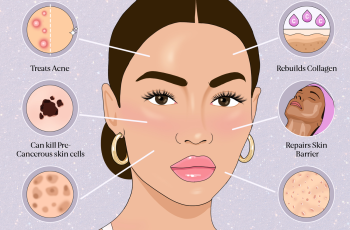
Where in My Skincare Routine Do I Need to Add Salicylic Acid?
When you start using salicylic acid in your skincare routine, figuring out where to place it can feel a bit overwhelming.
But once you understand its role and how it works with other products, it becomes much easier. Let’s break it down!
What Is Salicylic Acid?
Salicylic acid is a type of beta hydroxy acid (BHA) that works wonders for those dealing with acne, blackheads, or general breakouts.
Unlike alpha hydroxy acids (AHAs) like glycolic acid, which work on the surface of the skin, salicylic acid penetrates deep into the pores due to its small molecular size.
This allows it to break down excess oil and debris inside the pores, which can cause acne.
It’s also oil-soluble, meaning it can effectively clear out oil, bacteria, and dead skin cells from deep within your pores while also helping with surface-level exfoliation.
This makes it perfect for acne-prone skin.
Where Does Salicylic Acid Go in Your Routine?
When incorporating salicylic acid into your routine, remember the general skincare rule: apply products in order of their consistency, from thinnest to thickest.
So, whether you’re using a cleanser, toner, or serum, it all depends on the product formulation.
1. Salicylic Acid in Cleansers
Salicylic acid is commonly found in cleansers, which you apply first in your routine. A salicylic acid cleanser will help rid your skin of dirt, oil, and makeup while starting the exfoliation process.
You’d use this right after removing makeup or any other residue on your skin.
2. Salicylic Acid in Toners
Toners are often the next step after cleansing. If you’re using a salicylic acid toner, apply it directly after cleansing.
These toners work by sloughing off dead skin cells, preventing clogged pores, and helping reduce acne.
A salicylic acid toner is effective because it stays on your skin for a shorter period, meaning it’s less likely to cause irritation.
Since toners are thinner and more lightweight than serums or moisturizers, they should be used earlier in your routine.
3. Salicylic Acid Serums
Serums are typically more potent than toners and are meant to address more specific skincare concerns, such as acne.
Once your skin has built a tolerance to salicylic acid (which may take a few weeks), you can start using salicylic acid serum.
However, use it sparingly, especially at first, as serums are stronger and stay on your skin for longer periods.
Start by using the serum once or twice a week in the evening, and increase the frequency as your skin gets used to it.
What Else Can You Use with Salicylic Acid?
Salicylic acid works well in combination with several other ingredients, but not all should be layered together. Here are some combinations that work well:
Ingredients That Pair Well with Salicylic Acid:
Niacinamide: Niacinamide is great for calming the skin and regulating oil production, which is especially helpful for acne-prone skin.
You can use salicylic acid first to exfoliate and then apply niacinamide to help soothe and balance your skin.
Hyaluronic Acid: Hyaluronic acid is a humectant, meaning it draws moisture into the skin.
Applying salicylic acid first clears your pores, and then you can lock in moisture with hyaluronic acid for smooth, hydrated skin.
Peptides and Ceramides: These ingredients help restore the skin barrier, which can sometimes be compromised by exfoliating acids like salicylic acid.
So, adding them into your routine can help keep your skin healthy and balanced.
Ingredients to Use Sparingly with Salicylic Acid:
Retinol: Retinol and salicylic acid both promote skin cell turnover, but using them together may lead to irritation or dryness.
It’s best to use retinol at night on alternate days from salicylic acid or on separate days entirely.
Glycolic Acid: Like salicylic acid, glycolic acid is also an exfoliant, but it works at the skin’s surface.
Using both at the same time can be too harsh for your skin, so alternate their use—salicylic acid in the morning, glycolic acid at night, for example.
Which Goes First: Salicylic Acid or Hyaluronic Acid?
For best results, you should apply salicylic acid first, followed by hyaluronic acid. Salicylic acid helps remove dead skin cells and clear out the pores, revealing fresh skin.
This makes your skin more absorbent and primed for other products. Hyaluronic acid can then be applied to hydrate and lock moisture in, keeping your skin smooth and balanced.
This combination is perfect for acne-prone skin because it exfoliates and hydrates simultaneously, helping maintain a healthy moisture balance while treating blemishes.
How to Introduce Salicylic Acid to Your Routine
If you’re new to salicylic acid, it’s best to start slow. Begin with a salicylic acid toner or a gentle cleanser once or twice a week to let your skin get accustomed to it.
Over time, you can increase the frequency as your skin builds tolerance.
Once your skin is used to salicylic acid, you can begin using more concentrated products, such as serums or spot treatments, which can be applied as needed to target specific areas.
Remember to apply salicylic acid products at night initially, as it can make your skin more sensitive to the sun. Always apply sunscreen during the day, especially when using acids in your routine.
Should I Use Salicylic Acid Before Niacinamide?
Yes, you can use salicylic acid before niacinamide in your routine. Niacinamide helps reduce inflammation and balances oil production, which is ideal for acne-prone skin.
Salicylic acid will clear out the pores and exfoliate the skin, while niacinamide will calm and soothe it, helping with any redness or irritation.
Final Thoughts
Integrating salicylic acid into your skincare routine can significantly improve your skin’s clarity and texture, especially if you have acne-prone skin.
The key is to introduce it slowly, layering it correctly with other ingredients, and ensuring you’re using it in the proper order.
Be patient and allow your skin time to adjust, and always remember to protect your skin from the sun!
Feel free to reach out if you need more advice on how to make salicylic acid work for you. Let me know if you need help refining your routine!


